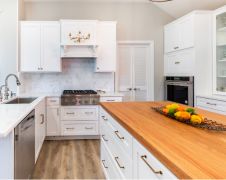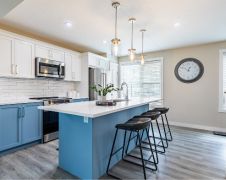The Complete Guide to Cabinet Refacing, Redooring, and Painting
Introduction
Your kitchen cabinets are the cornerstone of your space’s aesthetic and functionality. Over time, wear and tear, changing trends, and personal preferences may leave you wanting a refresh. But does that mean you need a complete kitchen remodel? Not necessarily! Cabinet refacing, redooring, and painting are cost-effective, time-efficient ways to revitalize your kitchen’s look without breaking the bank or enduring lengthy renovations.
In this guide, we’ll walk you through the processes, benefits, and differences between cabinet refacing, redooring, and painting. By the end, you’ll have a clear understanding of which option best suits your needs and how to get started. Plus, we'll offer expert advice on making the most of your kitchen renovation journey.
What Is Cabinet Refacing?
Cabinet refacing involves giving your existing cabinets a facelift by replacing their outward-facing surfaces while keeping the cabinet structure intact. This process typically includes:
- Replacing cabinet doors and drawer fronts.
- Applying veneer or laminate to the cabinet boxes.
- Upgrading hardware such as hinges, handles, and pulls.
Steps of the Cabinet Refacing Process Refacing your cabinets is a straightforward process that can be broken down into the following steps:
- Initial Consultation and Measurements: A professional evaluates your current cabinets, discusses material options, and takes precise measurements. For a free in-home consultation, visit Kitchen Tune-Up of East Brunswick!
- Material Selection: You choose the veneer, laminate, or wood finish for the cabinet boxes, along with new doors, drawer fronts, and hardware.
- Preparation: The old cabinet doors, drawer fronts, and hardware are removed, and the cabinet surfaces are cleaned to ensure proper adhesion of the new materials.
- Application of Veneer or Laminate: The cabinet boxes are carefully covered with a thin layer of veneer or laminate, ensuring a seamless and durable finish.
- Installation of Doors and Drawer Fronts: The new cabinet doors and drawer fronts are installed, aligned, and adjusted for a perfect fit.
- Hardware Upgrade: New hinges, handles, and pulls are added, enhancing the cabinets' functionality and appearance.
- Final Inspection: The finished cabinets are inspected for quality, and any necessary adjustments are made.
Materials and Techniques The most common materials used for refacing include wood veneer, laminate, and rigid thermofoil (RTF). The choice of material affects the cost, durability, and visual appeal of your cabinets. Wood veneer gives a rich, natural look, while laminate and RTF offer budget-friendly alternatives with plenty of style options.
Benefits of Refacing
- Cost-Effective: Refacing costs significantly less than replacing cabinets while achieving a like-new appearance.
- Eco-Friendly: By reusing the existing cabinet boxes, you minimize waste and reduce environmental impact.
- Quick Transformation: Most refacing projects can be completed in a matter of days, making it a convenient option for busy homeowners.
When to Choose Refacing
- Your cabinet boxes are structurally sound.
- You’re happy with the current layout of your kitchen.
- You want a fresh, updated look without a complete overhaul.
For a detailed comparison between the options, check out our blog posts: "Refacing vs. New Cabinets: Which is Best for Your Kitchen?" and "Refacing or Painting Kitchen Cabinets: Which Option is Best?".
What Is Cabinet Redooring?
Cabinet redooring focuses specifically on replacing the doors and drawer fronts of your cabinets while leaving the boxes and framework untouched. This process is less extensive than refacing but can still make a dramatic impact.
Steps Involved in Cabinet Redooring
- Assessment: Inspect the existing cabinet boxes to ensure they are in excellent condition and capable of supporting new doors.
- Measurements: Carefully measure all doors and drawer fronts to ensure precise replacements.
- Selection: Choose the door style, material, and finish that match or enhance your kitchen’s aesthetic.
- Replacement: Remove the old doors and drawer fronts, and install the new ones using upgraded or existing hardware.
- Finishing Touches: Ensure all adjustments are made for proper alignment and functionality, and clean the surfaces for a polished look.
Ideal Scenarios for Redooring
- Your cabinet boxes are in excellent condition but the doors are outdated or damaged.
- You want a straightforward, budget-friendly upgrade.
- You’re not looking to change the material or finish of the cabinet boxes.
Key Considerations
While redooring is simpler and cheaper than refacing, it’s limited in terms of customization. You’ll need to ensure that the new doors and drawer fronts match the existing cabinet framework in color, material, and finish. This option is ideal for homeowners who are satisfied with their kitchen’s basic look but want to refresh its style.
Basics of Cabinet Painting
Painting cabinets is one of the most budget-friendly options for refreshing your kitchen. This process involves sanding down the existing finish, applying primer, and painting the cabinet doors, drawer fronts, and boxes.
Steps Involved in Cabinet Painting
- Preparation: Remove cabinet doors and hardware, clean surfaces, and sand existing finishes to ensure a smooth base for painting.
- Priming: Apply a high-quality primer to ensure proper paint adhesion and durability.
- Painting: Use paint specifically designed for cabinets. Apply multiple thin coats to avoid drips and achieve a professional finish.
- Sealing: Add a protective topcoat to enhance durability and resist daily wear and tear.
Pros and Cons of Painting
- Pros:
- Budget-friendly and DIY-friendly.
- Endless color options for customization.
- Minimal downtime compared to other methods.
- Cons:
- Requires meticulous preparation to achieve professional results.
- Less durable than refacing or redooring, especially in high-traffic areas.
For homeowners who enjoy hands-on projects, painting is an excellent way to personalize your kitchen. However, professional assistance from Kitchen Tune-Up can ensure a flawless finish.
Comparison of Refacing, Redooring, and Painting
When deciding between refacing, redooring, or painting your cabinets, it's essential to consider factors such as budget, timeline, durability, and the level of transformation you aim to achieve. Here's a closer look at how these methods compare:
Cost
- Refacing: This moderately priced option involves replacing cabinet doors and applying a veneer or laminate to the cabinet boxes, making it a cost-effective choice for those seeking a near-complete makeover without replacing entire cabinets.
- Redooring: Redooring is typically lower in cost compared to refacing, as it focuses solely on swapping out the cabinet doors while leaving the boxes untouched. It’s a good middle-ground option for those on a tighter budget.
- Painting: Painting is the most budget-friendly option, as it requires only paint, tools, and labor. It’s an excellent choice for a quick and affordable refresh.
Durability
- Refacing: Offers high durability thanks to the installation of entirely new surfaces, including doors and veneers, which can withstand wear and tear for years.
- Redooring: Provides moderate durability. While new doors improve the cabinet’s appearance, the existing boxes remain unchanged, which may affect overall longevity.
- Painting: Though painting adds a fresh look, it has moderate durability and is more susceptible to chipping, especially in high-use areas like kitchens.
Timeline
- Refacing: Typically takes 2-4 days to complete, making it a relatively quick solution for a major transformation.
- Redooring: The fastest option, with most projects completed in just 1-2 days, as only the doors are replaced.
- Painting: Requires 3-5 days to complete, which includes preparation, multiple coats, and drying time.
Aesthetic
- Refacing: Delivers a like-new appearance by covering all visible surfaces and replacing doors, giving the cabinets a fully updated style.
- Redooring: Refreshes the look by focusing on the doors while retaining the original cabinet structure. It's a great choice for a subtle yet impactful update.
- Painting: Allows for a vibrant or classic refresh with new colors but doesn’t change the cabinet design or structure.
Customization
- Refacing: Offers a high degree of customization, with options for materials, finishes, colors, and hardware.
- Redooring: Provides moderate customization, limited to the design and finish of the new doors.
- Painting: Extremely versatile, as any color or paint finish can be applied, making it ideal for personalization.
When to Choose Each Method
- Refacing: This method is best for homeowners seeking a complete transformation without the waste or cost of full cabinet replacement. It’s perfect if you want a long-lasting and modern look with minimal disruption.
- Redooring: Ideal for those who prefer a budget-friendly way to refresh their cabinets. If your cabinet boxes are still in great shape but you want to update the style of the doors, redooring is the way to go.
- Painting: Perfect for budget-conscious homeowners who want a quick and creative solution. It’s also great for DIY enthusiasts who enjoy taking on home improvement projects. However, keep in mind the potential for chipping over time, especially in high-traffic areas.
FAQs
What Does Cabinet Refacing Mean?
Cabinet refacing is the process of replacing cabinet doors and drawer fronts and covering the visible surfaces of cabinet boxes with a new finish. It’s a cost-effective way to refresh your kitchen without replacing the entire cabinetry.
How Long Does Cabinet Refacing Last?
With proper maintenance, refaced cabinets can last 10-15 years or more. The lifespan depends on the materials used and the quality of the installation.
Is Cabinet Refacing a Good Idea?
Yes! Cabinet refacing is a great option if your cabinet boxes are in good condition and you’re happy with your kitchen layout. It offers a significant transformation at a fraction of the cost of replacing cabinets.
Upgrading your kitchen cabinets doesn’t have to involve a full remodel. Whether you choose refacing, redooring, or painting, each method has its unique benefits tailored to different needs and budgets. By understanding the processes and factors involved, you can make an informed decision that suits your style and lifestyle.
Ready to transform your kitchen? Visit our East Brunswick, NJ location for professional cabinet makeover services. If you’re still deciding which option is right for you, explore our blog for more insights and inspiration: "Refacing or Painting Kitchen Cabinets: Which Option is Best?".

